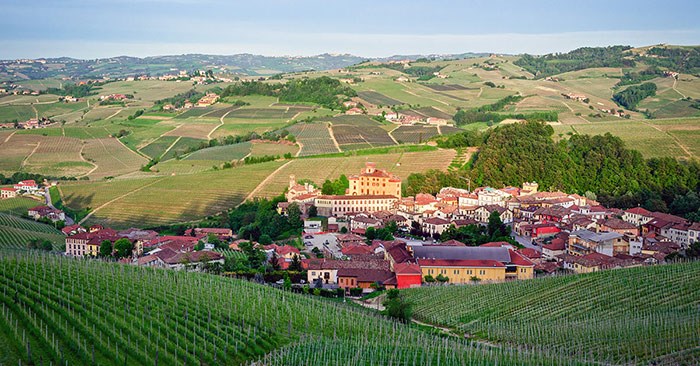 Photo: Vine Pair
Photo: Vine Pair
Of all of the words that advertisers use to convince us to buy stuff, I’ve become fascinated with the increasing use of “inspired”, because even a half-hearted de-construction of the term deflates any persuasive powers it may have. For instance: when we hear...
“Don’t just get any electric toothbrush, get one inspired by dentists”, what they are logically saying is:
“When we made that toothbrush, we were totally thinking about a dentist”. When we hear...
“Choose from 6 Chef-Inspired meals, fresh from your freezer”, they literally mean:
“When we froze the Lasagna, we were totally thinking about a Chef. Chef-thoughts all the way.” The folks making the ads count on us not thinking too deeply about the substance of the language, that’s how it works.
And it worked 150+ years ago, when a northern Italian aristocrat-turned-politician sought to turn his backwater village, whose most impressive crop up to that point was hills, into a world-class wine region whose wines were served in royal courts across Europe, i.e. they were wines “inspired” by Kings.
Not that the slopes surrounding the tiny, boring village of Barolo didn’t already grow grapes; Nebbiolo had been planted there since the 13th century (well suited to the region because it ripens late and doesn’t mind fog), but they only made wine for 3 reasons: lunches, Communion, and (in sufficient quantities) temporarily forgetting that your life is only lunches and Communions. Fine wine wasn’t made here; if Barolo residents saw a fine wine, like a Burgundy, they would have curiously poked it with a stick.
But Burgundy was on the mind of Camillo Benso, the Conte (or Count) di Cavour, mostly known simply as “Cavour” (only because they hadn’t thought of “Batman”). Cavour would become one of the early and central proponents of the Risorgimento, the Italian Unification movement that turned the boot from a quilt into a sheet, but in the 1850s, Piedmont belonged to the House of Savoy, which had once incorporated Burgundy, and Cavour had spent many months there falling head over heels for Pinot Noir.
He returned to Barolo and tried planting Pinot, but the temperamental grape wouldn’t take in foggy, hilly Piedmont and his crops failed hilariously, a lament he shared with his new drinking buddy, the elderly Marchesa di Barolo. The Marchesa wasn’t, in fact, Italian, her bachelorette name was Juliette Colbert, and before marrying the Marchesi di Barolo (with Napoleon’s consent), she spent her debutante years as a young lady in France drinking amazing Pinots, against which the local Nebbiolo hooch fared terribly. Both Cavour and the Marchesa missed French wine, and in a moment of clarity they determined that if you wanna make French wine, hire a French dude.
Enter Louis Oudart, a French winemaking consultant freshly employed by the Marchesa whose most saleable skill was yelling. He yelled at the grape growers for being greedy and not performing a green harvest (dropping half your berries before veraison and ripening) so that the grapes could fully ripen before winter weather, he yelled at the winemakers for keeping dirty cellars and at cellar masters for not controlling temperatures, the only thing Louis didn’t try to change was the indigenous plantings of Nebbiolo, because that would have culturally been a bridge too far (having lived through Napoleon, the locals did have a ceiling as to how many orders they’d take from a French guy).
Starting with the Marchesa’s own wines, the upgrade worked awesomely, the wines were riper and more consistent year after year, and subsequent vintages saw Louis Oudart’s modern practices spread to other houses in the Barolo village, and then to adjacent communes like La Morra, Castiglione Falletto, Serralunga d’Alba and Monforte d’Alba, all of which now produce wines under the modern appellation of “Barolo”. These newly improved Nebbiolos began to resemble the Burgundian wines that inspired the transformation: bold, medium-bodied reds with impressive longevity, higher acidity and, sometimes, pronounced tannins in youth. Barolo was now, in the mid-nineteenth century, creating world-class wines, but unfortunately for them the world had no idea.
And this is where Cavour’s knack for marketing kicked in. Using his connections with the house of Savoy (he later became their Prime Minister), Cavour began purveying the Marchesa’s Barolos to royal ceremonies, such as coronations and weddings (the way Champagne had done centuries before), pitching the wines as exclusively regal fare. Visiting princes and dignitaries would hear the phrase as their glasses were filled: “Barolo, King of Wines and Wine of Kings”, a saying that was lifted from Hungary’s Tokaji. If there is one thing royals like, it’s to be royal-er, and suddenly courts from all over Europe were ordering Barolos by the case load, a trend copied by upwardly mobile sorts and aspiring aristocrats. Barolo had taken hold from the top down, it willed itself into stardom. The rest is delicious history.
Written by Jordan Carrier, Vintage Room Consultant at Everything Wine – River District.


